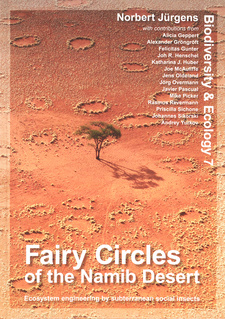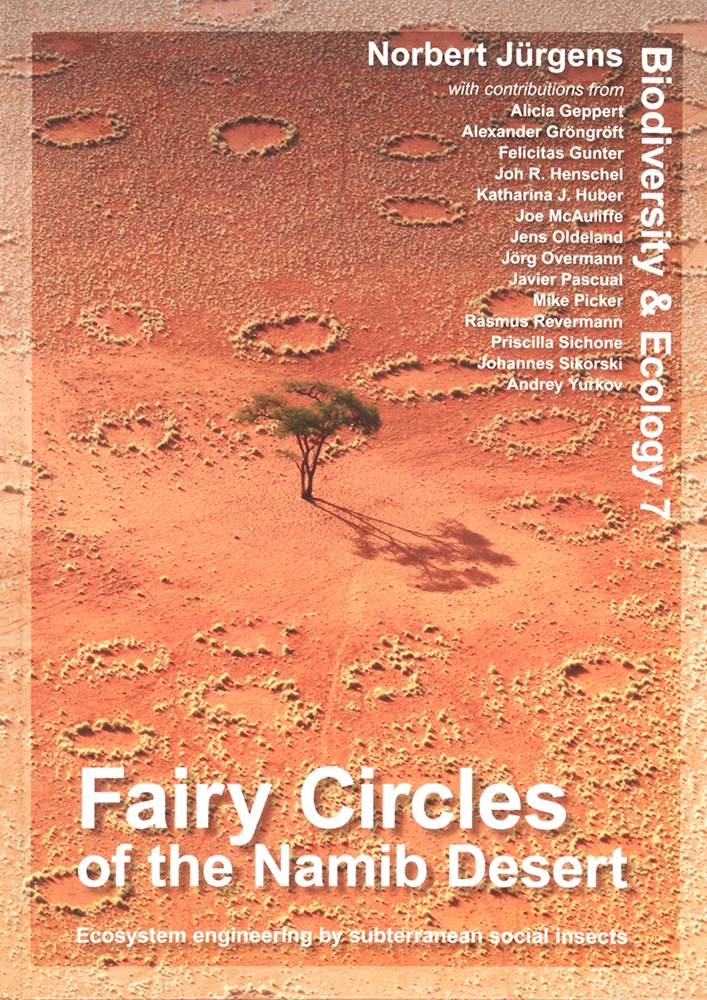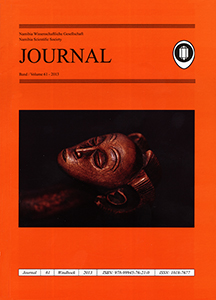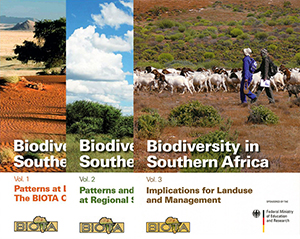Fairy Circles of the Namib Desert: Ecosystem engineering by subterranean social insects, by Ute Schmiedel, Manfred Finckh and Norbert Jürgens

Fairy Circles of the Namib Desert: Ecosystem engineering by subterranean social insects, by Ute Schmiedel, Manfred Finckh and Norbert Jürgens. Biodiversity & Ecology, Volume 7. Klaus Hess Publishers. Göttingen, Windhoek/Namibia 2022. ISBN 9783933117960 / ISBN 978-3-933117-96-0
Fairy Circles of the Namib Desert: Ecosystem engineering by subterranean social insects, by Ute Schmiedel, Manfred Finckh and Norbert Jürgens. From the editorial by Ute Schmiedel and Manfred Finckh:
The role of termites as ecosystem engineers in southern African drylands: overlooked, underestimated, and misinterpreted. Many people still consider termites as pests. However, growing evidence highlights their primordial role as ecosystem engineers that drive landscape heterogeneity and biodiversity (Jouquet et al. 2020). Termites provide a wide range of soil-related ecosystem services, such as litter decomposition, build-up of soil organic carbon, nutrient reallocation in landscapes and improvement of soil-hydraulic properties (Jouquet et al. 2011). Zanne et al. (2022) recently demonstrated how wood decay resulting from termites influences the global carbon cycle and how decay rates increase under global warming. Termites also play an essential role in the food chains of many vertebrates and invertebrates (Govorushko 2019). The present Biodiversity & Ecology volume focuses on the ecological role of termites in the drylands of southern Africa with emphasis on the Namib Desert. The primary author, Norbert Jürgens, dedicated four decades of his research to studying the flora and vegetation of the wider Namib Desert. He classified, mapped and analysed the geographical patterns of plant species distribution (Jürgens 1991) and studied the plants' morphological and anatomical adaptation (Jürgens 1986; 1996) and phylogeny (Jürgens et al. 2021) as well as the species composition (Jürgens et al. 2013) and vegetation dynamics (Jürgens et al. 1999). One of the topics that continuously attracted his interest concerned the vegetation patterns and processes around the so-called fairy circles (Jürgens 2013; Jürgens et al. 2015). However, the origin and ecological functions of these bare circles are highly contested. Numerous scientists of various disciplines have been intrigued by the phenomenon and presented contrasting hypotheses regarding the drivers of the bare circles in the landscape. Their explanations ranged from the release of toxic underground gases (Van Rooyen et al. 2004) and ants tending honeydew-secreting bugs (Picker et al. 2012) to self-regulation of the vegetation (Getzin et al. 2014; 2019; 2021). An overview of the history of fairy circle research is provided in Chapter 4 of this book. For this volume, Jürgens and co-authors from soil science, microbiology and zoology collate the broad range of research done by multidisciplinary teams and present a comprehensive description of Namib Fairy Circles (Chapter 3), the analysis of their life history (Chapter 5) and their role as ecosystems and landscape-forming elements (Chapter 6). The studies presented in this volume include aspects like the distribution and phylogeny of the termite taxa involved in fairy circle creation (Chapters 4.4 and 4.5 led by Felicitas Gunter), the climatic envelope of fairy circle landscapes (Chapter 7.3), the feedback of fairy circles on soil chemistry and hydrology (Chapter 7.4 and 7.5, led by Alexander Grongroft) and the plant interactions (Chapter 8.1), animals (Chapter 8.2 by Joh Henschel), fungi and other microorganisms (Chapter 8.3 and Chapter 8.4 led by Andrey Yurkov, Javier Pascual, Johannes Sikorski, Alicia Geppert, Katharina Huber and Jorg Overmann) with fairy circles. The presented results convincingly underpin the sand termite hypothesis for the origin of fairy circles. Towards the end of the present volume, the authors broaden the perspective of vegetation patterns in the Namib Desert, which are easily and frequently confused with fairy circles (Chapter 9 and Chapter 11). [...]
This is an excerpt from Fairy Circles of the Namib Desert: Ecosystem engineering by subterranean social insects, by Ute Schmiedel, Manfred Finckh and Norbert Jürgens.
Title: Fairy Circles of the Namib Desert
Subtitle: Ecosystem engineering by subterranean social insects
Editors: Manfred Finckh; Ute Schmiedel
Author: Norbert Jürgens
Series: Biodiversity & Ecology, Volume 7
Journal of the Division Biodiversity, Evolution and Ecology of Plants, Institute of Plant Science and Microbiology
University of Hamburg
Publisher: Klaus Hess Publishers
Göttingen, Namibia 2022
ISBN 9783933117960 / ISBN 978-3-933117-96-0
Hardcover, 21 x 30 cm, 376 pages, throughout photos, figures, tables and maps
Schmiedel, Ute und Finckh, Manfred und Jürgens, Norbert im Namibiana-Buchangebot
Fairy Circles of the Namib Desert: Ecosystem engineering by subterranean social insects
Fairy Circles of the Namib Desert: Ecosystem engineering by subterranean social insects. Biodiversity & Ecology, Volume 7
Journal 61-2013 (Namibia Wissenschaftliche Gesellschaft / Namibia Scientific Society)
Dies ist Band 61 des Journals der Namibia Wissenschaftliche Gesellschaft (Namibia Scientific Society), der 2013 herausgegeben wurde. Die Hauptbeiträge dieser Ausgabe sind in deutscher Sprache gehalten.
Biodiversity in southern Africa
Biodiversity in southern Africa introduces to results of 10 years of joint research by South African, Namibian, and German institutions within the project “BIOTA Southern Africa.



